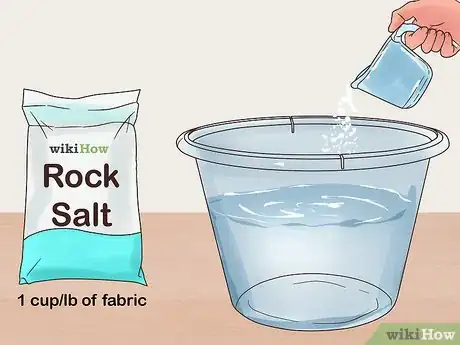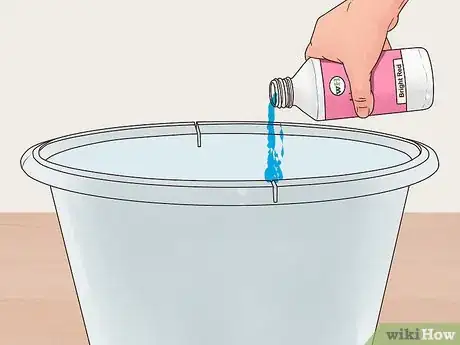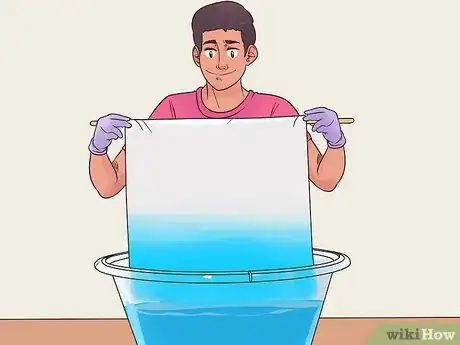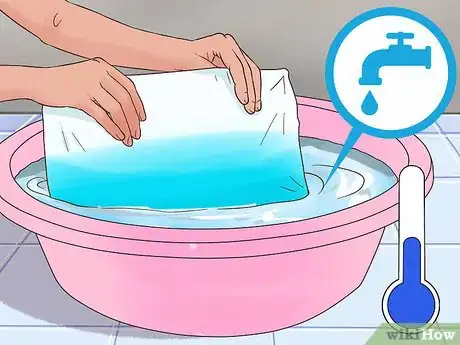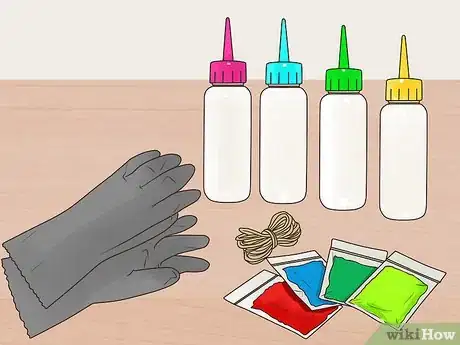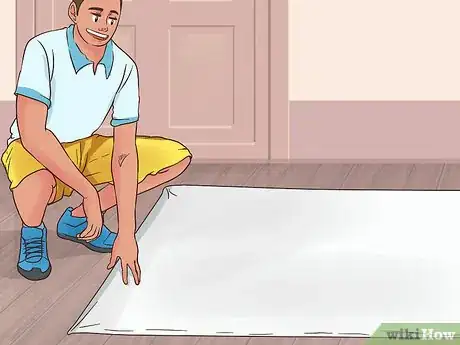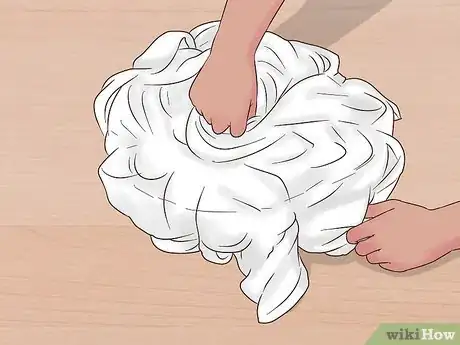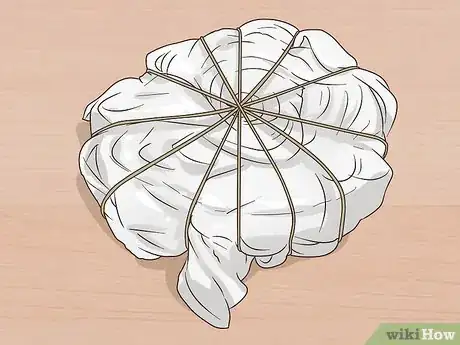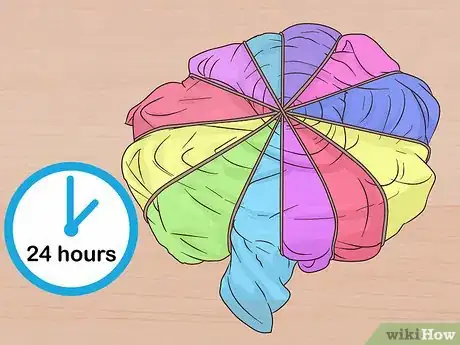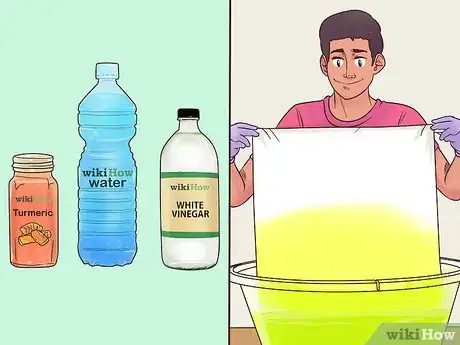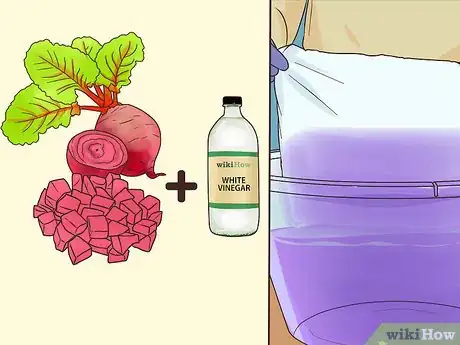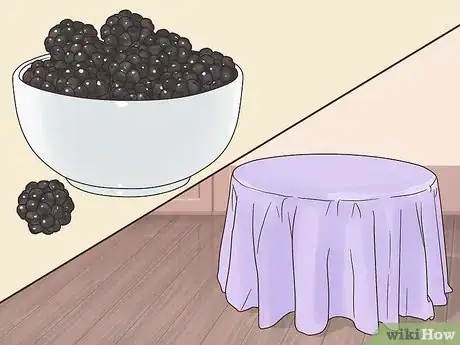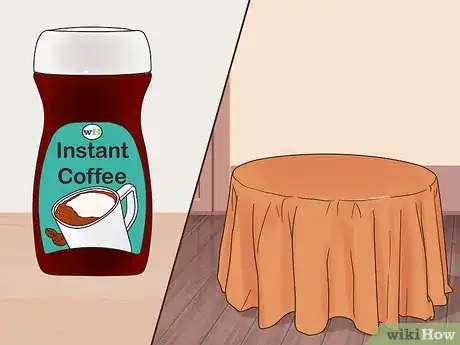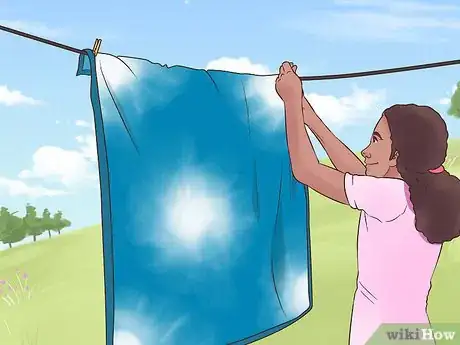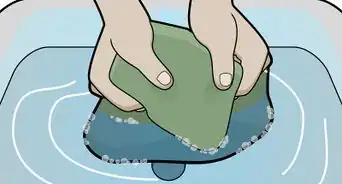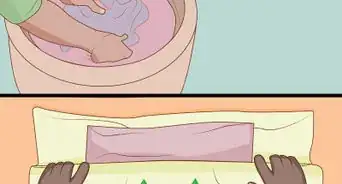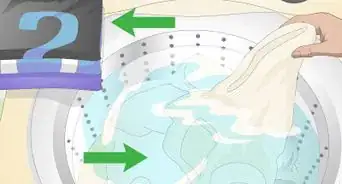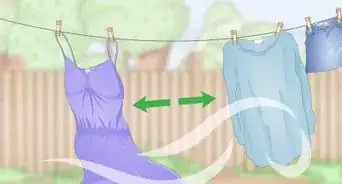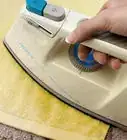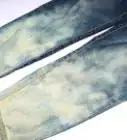This article was co-authored by wikiHow Staff. Our trained team of editors and researchers validate articles for accuracy and comprehensiveness. wikiHow's Content Management Team carefully monitors the work from our editorial staff to ensure that each article is backed by trusted research and meets our high quality standards.
This article has been viewed 16,874 times.
Learn more...
You can dye tablecloths using either fabric dye, natural dyes, and tie dyes. For best results, use these dyes on cotton, lace, or linen tablecloths. Mix your dye, saturate your tablecloth, let it soak for awhile, and rinse it in cold water. With a few ingredients and a little time, you can easily transform your plain tablecloths into bright, colorful accents!
Steps
Using Fabric Dye
-
1Choose to use either powder or liquid fabric dye. You can use either type of dye to color your tablecloth. Powder dye requires mixing the dye with liquid before you saturate your fabric, while liquid dye is ready to use.[1]
- Both are highly pigmented and easy to work with.
-
2Fill a large bucket or bin with 2 US gal (7.6 L) of very hot water. Turn on your faucet and let the warm water run for a few minutes to heat up. Then, fill up your container with water. Warm water helps your dye adhere to the fabric.[2]
- You want your water around 140 °F (60 °C).
Advertisement -
3Add 1 cup (236.6 g) of salt for every pound of fabric used. The amount of salt you need depends on the thickness and weight of your particular material. Measure out your salt and pour it into your warm water, then mix it up using a spoon.[3]
- The salt helps the dye penetrate the fabric and stay permanently.
- To find out how much your fabric weighs, read the packaging if it's a new tablecloth. If its an existing tablecloth, use an online fabric calculator based on your tablecloth's dimensions.
-
4Mix your dye in the bucket or bin as outlined on the packaging. On average, use 1⁄2 c (120 mL) of dye per pound of fabric. Pour your dye into the container using a measuring cup.[4]
- Each type of dye will have slightly different directions, so it’s important to read the particular instructions before you pour in your dye.
-
5Submerge your tablecloth for 5-20 minutes to dye it all 1 color. Dunk the tablecloth into your bucket or bin, and use a spoon to push it beneath the liquid. This way, all of the fabric gets saturated in the dye. Leave the dye in the solution for 5-20 minutes, as outlined in your directions.[5]
- Leave your tablecloth in the dye for a longer period of time for a highly saturated, vibrant look.
-
6Color only the edges of the fabric using a dowel rod for a dip-dyed look. Fold your tablecloth over top of a dowel rod so you can easily put the edges into the dye, and hold the dowel rod in your hands. Decide how much of the tablecloth you want to dye, and dip the end of the of the cloth into the dye. Leave it in the fabric for about 1 minute, then lift up so ⅔ of the fabric remains in the dye. Let the dye soak for another 2-3 minutes, and then lift up so the last ⅓ is still in the liquid. Leave the bottom ⅓ in the dye for 5-6 minutes.[6]
- Do this for both sides of your tablecloth for a symmetrical look.
- This creates a gradient effect across the edges of your tablecloth.
-
7Rinse your tablecloth in cold water and let it air dry. Turn on your faucet to the coldest setting, and wash away the dye from your tablecloth. Continue washing the material until the water runs clear. Then, wring out any extra water, and hang your tablecloth on an outdoor clothesline to dry.[7]
- You can use your garden hose or your sink to rinse your fabric.
- If you don’t have a clothesline, you can lay your tablecloth over your porch railing or banister.
Using Tie-Dye
-
1Mix the colors in a tie dye kit to prepare your dye. Included in these kits are gloves, rubber bands, applicator bottles, and dye pigments. Follow the included instructions regarding how to mix the dyes, as each type is slightly different. In general, you simply fill the bottles with water up to the fill line when you are ready to dye your tablecloth.[8]
- You can purchase an at-home tie dye kit from most craft supply stores.
- 1 kit with 3-4 bottles should be enough dye for 1 tablecloth.
- Avoid overfilling the bottles, as you can lose pigment.
-
2Spread out your tablecloth on a clean, flat surface. When dyeing your tablecloth, it is important to lay the material flat so you can prepare your pattern properly. If there are creases or wrinkles in it, the inside of the fabric may not get as saturated as the outer areas.[9]
- You can lay it on your deck, patio, or large table, for example.
-
3Pinch the middle of the tablecloth and spin your fabric to create a spiral. With your index middle and thumb, secure the center of the fabric, and start twisting your hand clockwise. As you do this, use your other hand to guide the fabric. When you reach the end of the fabric, hold it with both of your hands to keep it tight. Then, wrap the ball of fabric with 3-4 rubber bands to create 6-8 even sections.[10]
- This creates an all-over spiral pattern.
- If you are having trouble finding the center, fold the tablecloth in half lengthwise so it’s smaller and easier to work with.
-
4Section off your fabric starting at the center for a bullseye pattern. Pinch the center with your index finger and thumb, and pull the fabric up. Smooth the fabric into a solid bundle. Then, stretch a rubber band over the fabric about 2–4 in (5.1–10.2 cm) down from the end. Wrap the rubber band 1-3 times so it is tight. Continue doing this until you reach the end of your tablecloth.[11]
- This creates an evenly-spaced, ring pattern across your tablecloth.
-
5Fold the fabric into evenly-sized pleats to make stripes. Make vertical folds about 2–4 in (5.1–10.2 cm) wide starting at the edge of your tablecloth. Your folds should stack on top of eachother like a fan. Then, wrap your tablecloth 1-3 times with a rubber band about 2–4 in (5.1–10.2 cm) from the end. Continue segmenting your fabric until you reach the other end of the fabric.[12]
- This creates horizontal stripes across your tablecloth.
-
6Cover each section of your tablecloth with your tie dye. You can either dye each section a different color, or you can alternate 2-4 colors to create a pattern. To do this, squeeze the dye over the fabric in between the rubber banded sections. Avoid getting your tie dye on other sections.[13]
- Make sure you apply the dye to the inside of the bundle so the center of the tablecloth gets covered too.
-
7Let your dye soak inside a plastic bag for 24 hours for best results. Place your dyed tablecloth into a plastic grocery bag, and set it in a location where it will not be disturbed. Come back for it the next day, and rinse it under cold water until the water is clear. Then, launder your tie-dyed tablecloth in warm water, and let it air dry.[14]
- This way, your tablecloth will be highly saturated and colorful.
Dyeing with Natural Ingredients
-
1Use turmeric, water, and vinegar to dye your tablecloth yellow. Mix 4 c (950 mL) of vinegar with 16 c (3,800 mL) of water in a large pot, and turn your heat on medium. Place your fabric into the pot. As your fabric soaks, mix ¼ cup (59.15 g) of turmeric and 12 c (2,800 mL) of water and let it simmer. Let both pots sit for 1 hour with the heat on, and then dump out your vinegar mixture. Pour the dye over your fabric, and heat the fabric for 15-60 minutes.[15]
- If you’d like, you can fold the tablecloth into a small bundle so it’s easier to fit in the pot. Fold the tablecloth lengthwise 2 times, then alternate your folds to create a square. After your fabric is folded, wrap rubber bands around it horizontally and vertically to keep it in place.
- The vinegar helps your fabric absorb the natural color.
-
2Mix chopped beets and vinegar if you want to make a lavender dye. Cut up 2-3 large beets into small, quarter-size chunks. Fill a large pop ¾ of the way full with water, and dump in your beets. Bring this to a boil, and simmer your beets for 1 hour on low heat. Then, turn off the heat and add 1⁄2 c (120 mL) of vinegar. Slowly add your tablecloth to the pot until it is completely covered. Mix it up, and let the fabric soak for at least 2 hours.
-
3Use blackberries as another way to make lavender dye. Boil 3 cups (709.8 g) of berries and 8 c (1,900 mL) of water on high heat. Smash the berries with a spatula to release the juices. Lower your heat, and simmer your mixture for 15 minutes. Drain the liquid with a strainer, and use the liquid as your dye. Then, let your fabric soak in the dye for at least 2 hours.
-
4Use tea or coffee to dye your tablecloth a natural tan shade. To use tea, fill a large pot ⅔ full with water and bring it to a boil. Steep 40 tea bags for 15 minutes. To use coffee, boil a pot of hot water, turn off the heat, and add ½ cup (118.3 g) of instant coffee. Place a damp tablecloth into the pot, and ensure it is completely submerged. Soak the fabric for at least 1 hour. Rinse your tablecloth in cold water, and splash some vinegar on the cloth. Let it soak for 10 minutes.[16]
- Hold your fabric down with kitchen utensils if the fabric pokes through the surface.
- For a light dye, soak your tablecloth for 1-5 hours.
- For a dark pigment, leave your tablecloth in the dye overnight.
- The stronger the coffee or tea, the darker the color will be.
-
5Rinse your fabric with cool water after you dye the tablecloth. Once your tablecloth reaches your desired color, rinse the material in cool water. The cool water only removes the excess dye. You can do this using your sink, bathtub, or garden hose.[17]
- Warm water can strip the dye away from your fabric, making your tablecloth a lighter color.
-
6Let your fabric air dry for best results. Stretch your fabric out on a table, across your patio railing, or on a clean tarp. Then, let your tablecloth dry completely. After your fabric dries, you can place it on your table or wash it by itself if you'd like.[18]
- Using heat when your tablecloth is first drying can release the natural dye pigment, making your tablecloth look faded more quickly.
- After you've let your tablecloth dry completely, then you can use heat on your fabric.
Things You’ll Need
Using Fabric Dye
- Tablecloth
- Liquid or powder dye
- Gloves
- Bucket or bin
- Salt
- Spoon
- Water
- Dowel rod
Using Tie-Dye
- Tablecloth
- Tie dye kit
- Flat surface
- Rubber bands
- Applicator bottle
- Plastic bag
- Water
Dyeing with Natural Ingredients
- Tablecloth
- Beets, turmeric, coffee, or tea
- Vinegar
- Water
- Strainer
- Large pot
Warnings
- Never dry polyester tablecloths. The fabric dye does not work well with anything more than 50% polyester/50% cotton blends.⧼thumbs_response⧽
- After you dye your fabric, make sure you wash the tablecloth with similar colors or by itself the first time you launder it. If not, any remaining dye can wind up on your other clothing.⧼thumbs_response⧽
- Wear gloves when handling dye. It can stain your hands, as well as your clothes.⧼thumbs_response⧽
References
- ↑ https://www.thekitchn.com/how-to-dip-dye-a-tablecloth-projects-from-the-kitchen-212746
- ↑ https://www.thekitchn.com/how-to-dip-dye-a-tablecloth-projects-from-the-kitchen-212746
- ↑ https://www.thekitchn.com/how-to-dip-dye-a-tablecloth-projects-from-the-kitchen-212746
- ↑ https://www.thekitchn.com/how-to-dip-dye-a-tablecloth-projects-from-the-kitchen-212746
- ↑ https://www.thekitchn.com/how-to-dip-dye-a-tablecloth-projects-from-the-kitchen-212746
- ↑ https://www.thekitchn.com/how-to-dip-dye-a-tablecloth-projects-from-the-kitchen-212746
- ↑ https://www.thekitchn.com/how-to-dip-dye-a-tablecloth-projects-from-the-kitchen-212746
- ↑ https://www.homemadeinterest.com/red-white-and-blue-tie-dye-tablecloth/
- ↑ https://www.homemadeinterest.com/red-white-and-blue-tie-dye-tablecloth/
- ↑ https://www.homemadeinterest.com/red-white-and-blue-tie-dye-tablecloth/
- ↑ https://www.homemadeinterest.com/red-white-and-blue-tie-dye-tablecloth/
- ↑ https://www.homemadeinterest.com/red-white-and-blue-tie-dye-tablecloth/
- ↑ https://www.homemadeinterest.com/red-white-and-blue-tie-dye-tablecloth/
- ↑ https://www.homemadeinterest.com/red-white-and-blue-tie-dye-tablecloth/
- ↑ https://www.remodelista.com/posts/diy-natural-dye-turmeric-dyed-tablecloth/amp/
- ↑ https://www.apartmenttherapy.com/how-to-dye-textiles-with-coffee-tea-108438
- ↑ https://www.remodelista.com/posts/diy-natural-dye-turmeric-dyed-tablecloth/amp/
- ↑ https://www.remodelista.com/posts/diy-natural-dye-turmeric-dyed-tablecloth/amp/
- ↑ https://www.apartmenttherapy.com/how-to-dye-textiles-with-coffee-tea-108438
- ↑ https://www.apartmenttherapy.com/how-to-dye-textiles-with-coffee-tea-108438


